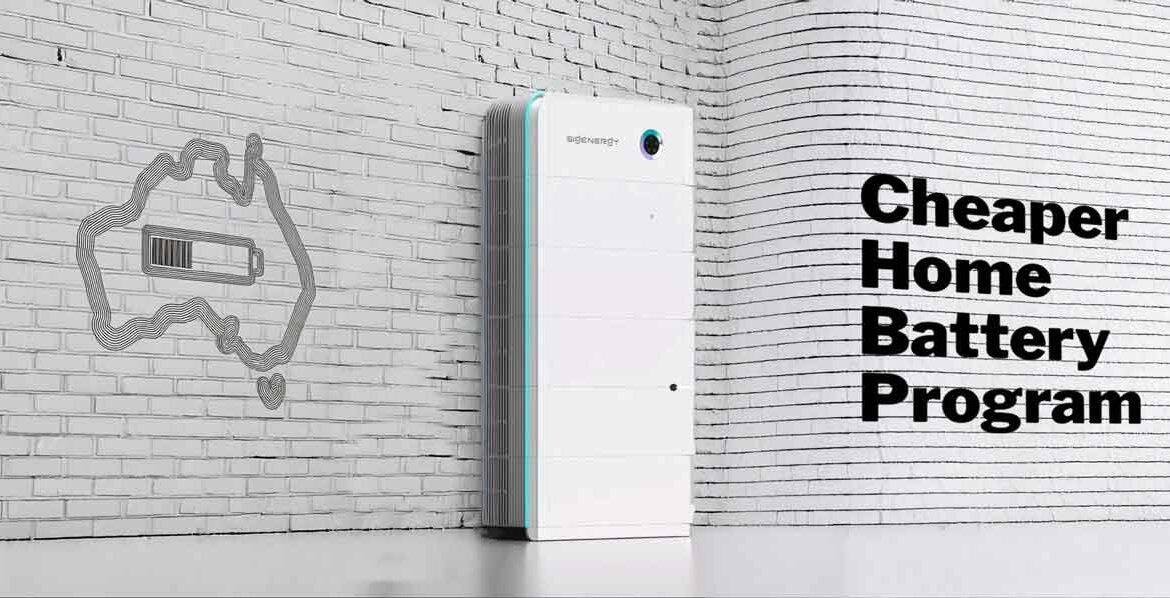The Federal government’s new $2.3 billion Cheaper Home Batteries Program offers a generous battery discount for Aussie households and small businesses.
Here’s the rundown on adding a battery to your home or business with the new Program.Battery boom ahead
Households and businesses are set to benefit from a ~30% discount on installing a battery. Which makes adding energy storage much more accessible. The battery payback period for most solar homes should now be well under 10 years. Households adding a battery can expect lower electricity bills. At the same time, everyone on the grid will also see the benefits. That’s because batteries will relieve pressure on generation at peak times by effectively moving their own cheap daytime renewable energy into the evening peak, helping to reduce overall electricity costs.
What’s the deal?
The Federal Government’s Cheaper Home Batteries Program starts from July 1 2025 and is scheduled to run until 2030. Battery buyers receive a discount directly from their installer, with nothing to claim. The Program uses the same STC renewable certificate system as solar panels. The discount is about $372 per kWh of installed battery in 2025. This will save around $4000 on installing a 14kWh battery.
Each year, the value of STC certificates will fall by about 10%. As a result, the discount in 2030 will only be around half of this year’s savings.
Eligible battery systems
At the end of May, final regulations had not been confirmed, however the Federal governement’s website offered guidance on the the Cheaper Home Batteries Program, which the industry is actively following. Here’s a guideline on what’s needed to receive the discount on a new battery through the Cheaper Home Batteries Program.
- There must be solar at the home – either existing or new.
- Battery systems must be between 5kWh to 100kWh. The rebate only applies for the first 50kWh.
- The Program only supports standalone home batteries, so electric vehicles are not eligible.
- The battery must be VPP capable – but you won’t need to join a VPP. Find out more about current VPP offers for battery homes here.
- The system must be installed after July 1 2025. The ‘installation’ is the date when a certificate of electrical compliance or equivalent is signed. Batteries might be installed before this date but must not be connected until July 1 to be eligible.
- The battery system and inverter must be listed on the Clean Energy Council (CEC) approved product list. A CEC-approved installer must install the storage system.
- The discount will not be provided for any additional storage that is added at a later date.
Get it right the first time.
Doing your research to get it right is important because it’s a big investment, and the discount is only available once. While there is a rush on right now, there is plenty of time, despite what the three texts from the battery installer tell you!
For solar homes looking to take advantage of the Cheaper Home Batteries Program, here are a couple of things that we think are well worth considering;
Think about Quality.
A quality battery brand may cost more but offers better support should an issue occur. There are more than 60 battery brands available in the Australian market. An obscure, cheap battery brand that fails at year five and is no longer supported means you are back to square one. At the same time, quality battery brands also give households access to a broader range of VPPs. This can help improve your investment ROI. See here the list of retailer VPPs generally available for each battery brand.
Consider upsizing
The Cheaper Home Batteries Program discount is only offered once for each property. It makes sense to think ahead and install sufficient storage to support the household over the next decade. You can read more on battery sizing here. The minimum battery size should cover your peak energy use. However, there are several good reasons why it’s well worth considering upsizing.
- Battery capacity will diminish over time. This leaves you with less storage in the future – expect capacity to fall by at least 20% across a decade.
- Households will likely be using more energy in the future. Some will add an EV, meaning they’ll want to access more power to charge overnight. At the same time, other battery households will happily use more energy to heat and cool their home because they can, thanks to solar/low-cost stored energy. Enjoying more comfort each day is a benefit of investing in a battery.
- It’s cheaper to upsize now and receive a discount than to add storage later and pay full price. Plus, a little more $ can get a lot more kWh. Adding an extra battery pack provides greater value with modular battery systems. For example, a 16kWh storage system (including an inverter, gateway, installation, smoke alarm, etc.) might cost $12,000 to install after the discount is applied. Adding an extra 8kWh battery module grows the system to 24kWh, with a price increasing to $15,000. So, the household gains 50% more storage for a 25% cost increase. So, it’s worth asking about the cost to go bigger.
- Going bigger means the battery will have the capacity to comfortably join a VPP, helping yourself and the wider community. Regularly using extra storage can help acheiving a swifter return on your investment. Typical VPPs offer $180-$240 annually for using around 200kWh-400kWh of your storage (an effective feed-in tariff of 50 cents/kWh to $1/kWh for VPP exports). While joining a retailer like Amber that offers market-linked pricing creates the opportunity to export as much energy as you’d like at the wholesale price – often averaging to 20-30cents/kWh in the evening peak with spikes up to $15/kWh (once or twice a year!). See WATTever’s comparison of Energy Retailer VPPs here.

